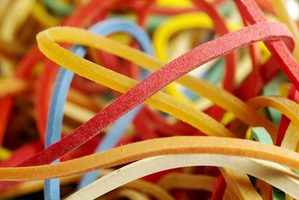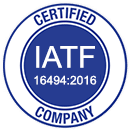What is “Rubber?”
“Rubber” refers to elastomeric compounds that consist of various monomer units forming polymers that are heat cured (vulcanized). Polymers are long molecular chains and are derived from the Greek “poly” (many) and “meros” (parts). The base monomer or monomers is used to classify the type of rubber, for example: Nitrile, Silicone or Neoprene.
 Rubber Ingredients
Rubber Ingredients
Rubber is composed of many different ingredients that include the base elastomer, vulcanization agents, fillers and plasticizers. For example, the addition of fillers can reinforce or modify properties, or additional plasticizer can increase elongation and lower durometer.
Why Does Rubber Act “Rubbery?”
A polymer is considered a very viscous liquid or an elastic solid (i.e. rubber). The polymeric chains in rubber tend to be very long and flexible by nature and can rotate about their axis, which results in an entangled mass of contorted chains.
When a deformation of the rubber occurs, these tangled chains uncoil and recoil when the force is released. Therefore, elastic rebound or rubbery behavior is possible due to contortions of long, flexible polymeric chains, which allows rubber to be so resilient.
How is Rubber Made?
The elastomer is the basic component of all rubber recipes and is selected in order to obtain specific physical properties in the final product. Processing aids and softeners, such as oils and plasticizers, modify rubber to aid in mixing or molding operations.
Sulfur is one of the most widely used vulcanizing agents to promote crosslinking which is used in conjunction with accelerators and accelerator activators to reduce cure times and enhance physical properties.
Carbon black is one of the most common fillers because it reinforces the molecular structure. Antidegradants, such as antioxidants and antiozonants, retard the deterioration of rubber products. Lubricants, colors or any other miscellaneous ingredients may also be added.
What is Vulcanization?
The long, flexible polymeric chains of rubber, when heated, react with vulcanizing agents to form three-dimensional structures. These vulcanizing agents (usually sulfur or peroxide) are necessary to facilitate chemical crosslinking of polymeric chains. Once the rubber has been vulcanized or “cured”, physical properties are enhanced and the compound is more resistant to deterioration.
What is Compression Set?
Elastic recovery is a measure of the elastomer’s ability to return to its original shape once a compressive force has been removed. Failure of the seal to return to its original shape after compression is the condition termed “compression set” and all seals exhibit some degree of compression set.
Determination of the amount of compression set is governed by ASTM designation D395 test procedure.
What is the difference between a Thermoset and Thermoplastic?
One classification method of polymeric materials is according to physical properties at elevated temperatures. Thermoset polymers become permanently “set” in the presence of heat and do not soften in the presence of subsequent heating. Conversely, a thermoplastic material will soften when heated (and eventually liquefy) and harden when cooled.
This process is reversible and repeatable, as opposed to thermosetting polymers where the process is irreversible. Also, thermoset polymers possess superior mechanical, thermal, and chemical properties as well as better dimensional stability than thermoplastics. This is why thermoset (rubber) parts are generally preferred for sealing applications.
This section contains descriptions of the elastomers used in seal applications. These elastomers form the base of a wide variety of compounds, designated for specific applications. Every compound has specific characteristics and many compounds have common attributes. Therefore, it is important to consider all aspects of the compound prior to use. Also, as compound availability is customer-driven, lead times may vary.
Other Resources
Please fill out the form below to receive information regarding your inquiry. You can give us a call at (626) 965-9966, or please bare with us while we reply to your inquiry.
Error: Contact form not found.








